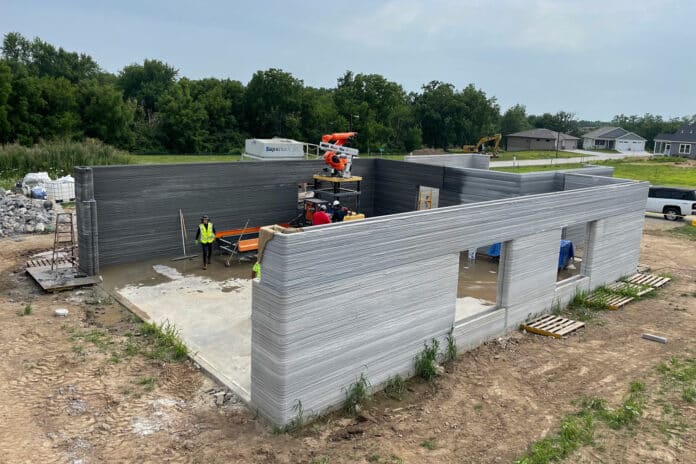3D printing technology has the potential to transform the US homebuilding industry by offering faster, cheaper, and better solutions for housing. Surprisingly, 3D-printed structures that were once considered impossible to build are now becoming a reality, and progress is happening at an impressive speed.
Alquist 3D, a leading 3D construction company, recently completed the first 3D-printed house in Muscatine, Iowa, using RIC Technology’s advanced robotic arm-based 3D printing system. The construction began in October of this year, and the company finished printing the home’s ten-foot-tall exterior walls in November.
The new 3D printing system by RIC Technology employs advanced robotic arms to build the entire house in a highly automated process, freeing up human labor from dangerous and tiring work.
Compared to conventional gantry-based 3D construction systems that can cost thousands of dollars in labor and equipment rental fees and take up to 3 days to set up, the new system eliminates the need for a massive framework to support the printer head during the printing process. Transporting the gigantic gantry-based system to a construction site typically requires disassembly and the use of three semi-trucks, a large-scale crane, and a telehandler.
RIC Technology’s robotic arm system has some unique advantages over other systems on the market. Its retractable design and compact size make it easy to transport and quick to set up, which can significantly reduce labor and transportation costs. The robotic arm system requires no assembly and can be operational in 2-4 hours. Additionally, this system can cut construction costs in multiple areas, including transportation, setup, and daily operations.
“Compared to gantry-based 3D printing, our robotic arms can reduce costs by about $16,000 per home,” said Ziyou Xu, founder of RIC Technology. “Robotic arm-based 3D printing is one of the most promising solutions to address the global housing shortage crisis.”
In addition, 3D-printed houses promise significant energy savings, lowering the energy expenses of the occupants by 30% due to the insulation features of the houses. 3D-printed homes are also very resilient to withstand natural disasters and extreme weather conditions, such as the harsh winter in Iowa.
According to Xu, the technology enables builders to construct more affordable, resilient, and durable homes with fewer resources and lower costs. That is why the City of Muscatine, in partnership with The Community Foundation and Alquist 3D, began building a set of 10 homes in Muscatine, Iowa, using RIC’s groundbreaking system.
It was the second site Alquist 3D built on in Muscatine. The first house, which initially broke ground in May, was supposed to showcase the company’s innovative technology, which had already been used for Habitat for Humanity projects. However, the project faced a setback in late November when Alquist had to demolish the first of these ten homes before it could be completed. The reason was that the printing mix failed to reach the required 5,000-psi strength level, raising doubts among structural engineers about the durability of the material.
RIC Technology’s innovative technology is not only being used in Muscatine but also in other parts of the world, such as Australia and Rwanda. The company is committed to revolutionizing the 3D printing industry by providing cost-effective, time-saving, and labor-reducing solutions for the global housing market.
